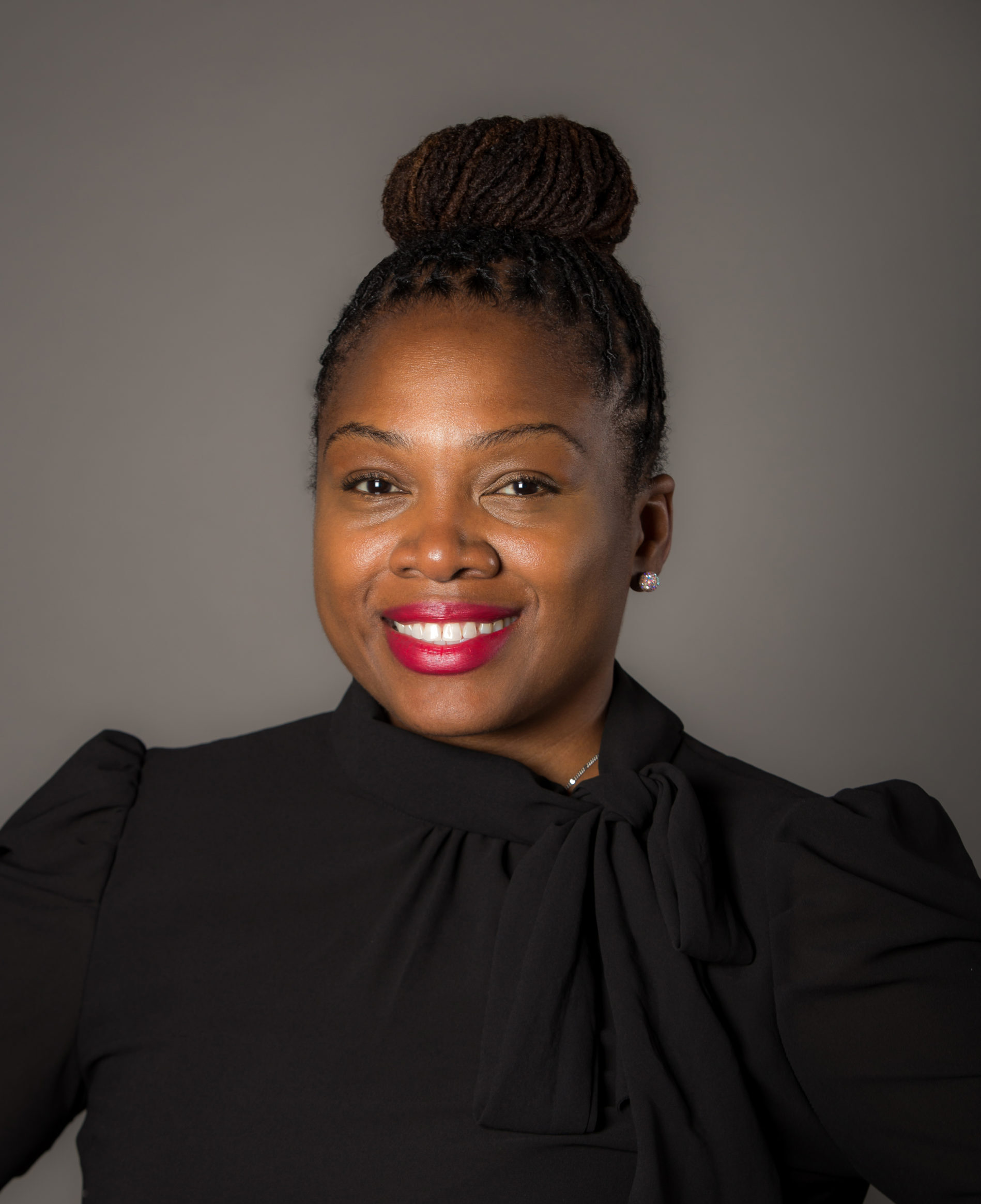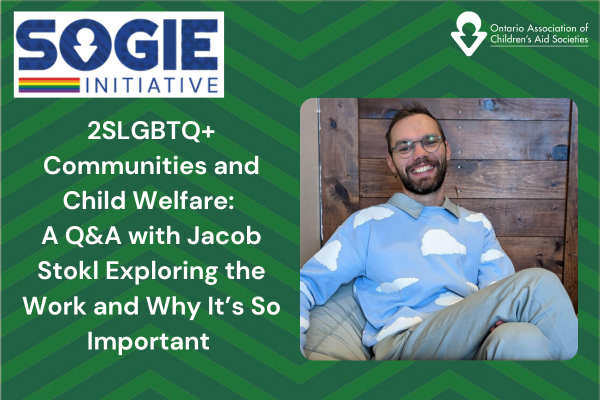
In March 2022, the Ministry of Children, Community, and Social Services (MCCSS) announced funding to develop new services and supports that respond to the distinct needs of 2SLGBTQ+ children, youth, and families. The work of the SOGIE Initiative has progressed quickly and with great success in this time. Below, 2SLGBTQ+ Analyst Jacob Stokl, project lead at OACAS, shares more about the priorities of the work, why it’s important, and what’s next.

Tell us a bit about the SOGIE Initiative and the work involved in it. What are the goals of the project?
So much has been happening since the initial launch of this initiative in April 2022. The project is multi-faceted, and we’ve had a lot on the go. We’ve connected with youth, caregivers, and staff to establish key priorities for the project; done work focusing on youth engagement like the Q-munity Youth Symposium and Camp Lifting Leaves; trained new facilitators to deliver the Sexual Orientation, Gender Identity and Expression (SOGIE) Curriculum; established a 2SLGBTQIA+ Provincial Roundtable, and more. Recently, we initiated a virtual drop-in program called Leaf Links for 2SLGBTQ+ youth, in collaboration with Project Ten Oaks, to ensure youth are staying connected year-round.
Given that there are so many pieces to this project, its goals are also varied. Some of the activities focus on addressing the disparities and disproportionality that 2SLGBTQ+ children, youth, and families face being involved with the child welfare system. We also have activities to address experiences of 2SLGBTQ+ identified child welfare staff who may feel unsafe or invisible in their own agencies. The central goal of this project is to provide OACAS’ member agencies with education, guidance, and tools to provide service that meets the unique needs of 2SLGBTQ+ children, youth, and families in their communities.
Why is this work important?
This work is critical because it so often goes ignored. We need to be diligent about recognizing the identities of the children, youth, and families served by child welfare, and that includes their sexual orientation, gender identity, and expression. We can’t possibly provide services that meet the needs of this community if we aren’t aware that they’re there in the first place.
Research has shown us that queer youth face many challenges: family and community rejection, lack of support, higher rates of poverty, higher risk of human trafficking, and an inability to access appropriate and affirming healthcare. These challenges underscore the importance of ensuring we are attuned to the unique needs of 2SLGBTQ+ communities.
What are you most looking forward to over the next year?
After reflecting on the programming of the SOGIE Initiative so far, we realized that we needed more youth voice incorporated into the project. Within the SOGIE Initiative, there are activities that offer opportunities for 2SLGBTQ+ youth to connect, build community, acquire new skills, learn about themselves and their communities, and more. However, besides post-event surveys, or pre-event focus groups, there is a lack of consistent, reliable input from 2SLGBTQ+ youth on the issues that are impacting their experiences within the child welfare system. In 2024, we will be launching a recruitment process for a SOGIE Initiative Youth Council made up of 2SLGBTQ+ youth involved with the child welfare system. The Youth Council will provide an opportunity to incorporate youth voice into every aspect of the work.
What are the program’s biggest priorities for 2024-25?
There are a few key priorities this year. Most imminently, we have the next phase of our Disparity Mapping Project in partnership with Dr. Shelley Craig from University of Toronto coming up. A decision-making tool has been developed to support child welfare staff in identifying disparities in service for 2SLGBTQ+ children, youth, and families. We will be moving the decision-making tool into a pilot process, working closely with an agency who will work to integrate the tool into their service model and ensure it has positive impact.
Prioritizing children and youth will remain at the centre of this work, and so the youth-focused events like Camp Lifting Leaves, Leaf Links, and the newly announced SOGIE Initiative Youth Council will continue to be a big focus. We want to ensure that youth have multiple avenues to connect with each other. One of the biggest protective factors for 2SLGBTQ+ youth is engagement with the 2SLGBTQ+ community, so creating more opportunities for youth who may share similar experiences to form relationships is such an important facet of this work.
What are the biggest challenges the child welfare sector faces in this work? How might we overcome them?
One of the biggest challenges we face as a sector in this work is visibility. Right now, we don’t have meaningful or measurable ways to track how many 2SLGBTQ+ children, youth, and families are involved with our system. Without this data, it’s hard for us to bring the conversation to the forefront. However, data from other jurisdictions has shown us that 2SLGBTQ+ youth involved in child welfare systems are more likely to experience violence in group placements, are more likely to have multiple placements, and less likely to achieve permanency. This invisibility is exacerbated by feelings of discomfort by professionals and caregivers to have active dialogue about topics like sex, sexuality, gender identity, and gender expression with the service users they engage with.
There are two major ways we can address these challenges. First, we need to develop mechanisms in the Child Protection Information Network (CPIN) —that’s the centralized database that child welfare agencies use to capture data about the individuals they work with— to capture identity pieces like pronouns, identified names (not just legal names), gender identity, and sexual orientation. This would allow us to begin to understand who we are serving so that our strategies to support this community can be more specific and lead to better outcomes. A CPIN design group is being formed in collaboration with MCCSS to begin to tackle these SOGIE-data related questions.
Second, we need to educate child welfare staff, caregivers, and the community at large about SOGIE concepts. 2SLGBTQ+ youth who are involved with child welfare already face big challenges in their lives, and there can be an additional burden of “coming out” while also educating the people around them. We need to normalize conversations about sexual orientation, gender identity, and expression. OACAS offers learning modules and a SOGIE Curriculum to support child welfare staff and caregivers build knowledge to provide culturally informed, safe, and affirming services for 2SLGBTQ+ children, youth, and families.
What motivates and inspires you in this work?
Of course, at the heart of this work is a passion for supporting queer children and youth. 2SLGBTQ+ youth deserve to grow up in homes that support and affirm their identities. They deserve safety, well-being, and the ability to thrive. And it is that vision, a place where 2SLGBTQ+ youth are free to be themselves without fear of rejection or reprisal, that is my north star in this work. I have had the privilege of engaging with many queer youth since being in this role and they have shared so much vulnerability, insight, and knowledge about their experiences with me. It is impossible not to be inspired by them. I know that if we continue to centre the voices of these youth in this project, we will be headed in the right direction.
To learn more about the work of the SOGIE Initiative, click here.